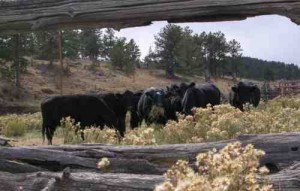Column by John Mattingly
Agriculture – January 2008 – Colorado Central Magazine
“We farmers are going to have the world by the tail with a downhill pull.”
I first heard this from a neighbor in the spring of 1968 when I started farming, and though the words were sometimes different over the next 40 years, the notion was always the same: farmers are bound to get what they richly deserve from the markets.
This idea was derived from several superficially reasonable, but ultimately flawed notions.
1. “They aren’t making any more land.”
While true, this ignores the human potential to extract more and more from less and less land. Since 1968, yields per acre of productive land have more than tripled for most commodities, due to integration of sophisticated inputs and application of various technologies. And, when this combination of ingenuities was applied to land previously deemed barren, suddenly there was even more land in production. Lands that were too hilly or salty, overgrazed or overgrown, unnoticed or underworked became highly productive farms. And not just in the United States. This Green Revolution happened worldwide. Nations such as India, Brazil, and China, former importers of foodstuff commodities, became net exporters of same.
So, although no more land was being made, more was being made of the land.
2. “Houses are covering all the good farms.”
Urban sprawl looks intimidating from the perspective of a car, driving from town to country and back. But fly over the United States coast to coast, and look down for four hours. From this perspective, you see urban areas are generally clustered, and farmlands are definitely extensive. There’s still a lot of empty space out there.
Good farms usually hold out against development. In urban areas, one will often see the last few good farms surrounded by houses.
Finally, talk to a developer about how long it takes to get a 10-acre subdivision approved, and then talk to a farmer who just put up 10 center pivots on old rangeland and now irrigates 1200 acres of corn and beans. The farmer’s pivots are running over sprouted crops while the developer is still waiting for final approval on some facet of the project.
So although lots of houses are being built, and some good farms are growing wood and concrete, the extent to which houses are encroaching on U.S. farmland is proportionally similar to the extent to which a football encroaches on a football field.
3. “The human population will outpace the food supply, a/k/a People have to eat.”
In the late 1960s, the Club of Rome predicted worldwide famine by the year 2000 due in large part to the population explosion. But the bomb never went off. It smoked, but no bang. World population leveled a bit, and the food supply accelerated exponentially. The quality of the food can be debated, but its quantity cannot. There are plenty of calories available at a reasonable price worldwide, notwithstanding that mal- distribution of foodstuffs causes more malnutrition than shortage.
4. “Resources are finite, so scarcity is inevitable.”
Not quite. A famous 1980 wager between eco-doomsdayer Paul Ehrlich and cornucopian Julian Simon-Ehrlich (in which Ehrlich bet five major commodities would be scarce and expensive in ten years, and Simon bet the same commodities would be plentiful and cheaper in the same period) was won handily by Simon.
Ehrlich’s prediction didn’t figure on the power of substitution and the dynamic impacts of technology. Nor did it take into account that inventory numbers taken in 1980 might be vastly understated. Take oil for example. Numbers are given as to “oil reserves.” Has anyone noticed that, based on these numbers, we keep reaching, then surpassing, “peak oil” — first in 1960 and then again last year.
Why? Because new “reserves” are regularly discovered. And oil companies have no incentive to accurately report their reserves. To do so gives markets the idea that there’s plenty in the ground, which would drive down prices. As a farmer, I’ve been known to understate inventory numbers when the U.S. ag census calls and asks me how many bushels of wheat or barley I have in storage.
5. Farmers are basically saints in overalls.
Farmers enjoy a good public image because most people think farmers work very hard and are cut from the cloth of Thomas Jefferson’s “incorruptible peasants.” There is some grumbling about farmers who collect big subsidies, but these are not dominant in our image of the American Farmer. But the good will bestowed on farmers by the public is nothing compared to the hubris of many farmers themselves, who earnestly believe that because they are doing something that is arguably essential, they deserve to succeed, even when they are stupid.
Farmers say things like, “Don’t criticize me with your mouth full,” even though very few people actually criticize a working farmer. Or farmers say, “I feed the world.” As I have pointed out in previous articles, without the help of the support industries — from bankers to fertilizer dealers to seed companies, from grain elevators to the miners who mined the ore that became a tractor — and without this underlying pyramid of helpers, most farmers would be hard pressed to feed themselves.
But, something different IS happening now.
Wheat is at nearly $9.00 a bushel, corn bumping $4 a bushel, soybeans at about $10 a bushel, prices that are two to three times what they have been for over a decade. Much of this price spike is driven by the political support garnered by the corn lobby for ethanol, which is a dubious endeavor scientifically if not financially. Nevertheless ethanol is supported by the current administration with certain tax credits because it rings the noble chant that we are somehow freeing ourselves from imported fossil fuels, apparently taking the posture of an ostrich regarding the fossil fuels it takes to grow the corn.
The Energy Balance (a ratio of the units of biofuel energy produced as numerator, and the units of fossil fuel energy required for biofuel production as denominator) for ethanol is one of the most consistency challenged numbers of the last three years. The corn growers claim a ratio of 4.7, various universities claim anywhere from 0.88 to 2.33, with a most recent, well-considered consensus at 1.35, which claims ethanol yields 35% more energy than went into its production.
But this most recent data relies on “a standard farm,” which exists only in the pastoral minds of academics, and “average inputs,” which can drown in a single inch of analysis. Further, the recent data gives no ledger status to externalized costs — such as all the environmental afflictions of the industrial ag machine — while giving externalized benefits to the cleaner emissions from an ethanol-burning engine. On balance, ethanol really doesn’t reduce our dependence on oil as much as it shuffles the deck to increase the chances of farmers getting more for their crops due to the expanded, though subsidized, market for corn.
As a farmer, I feel an eerie satisfaction from the price spike in ag commodities. On one hand I’m getting more money for my crops, but for an unsustainable reason. Much as I’d like to be high and mighty, I cashed the check from the elevator, having learned to take it as it comes, high or low, right or wrong.
John Mattingly has farmed in many places, among them the northern San Luis Valley near Moffat.


